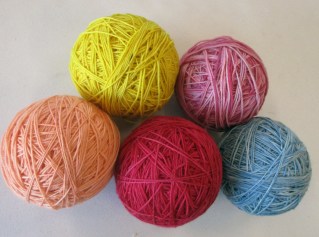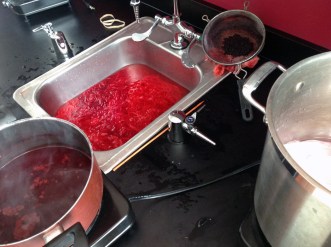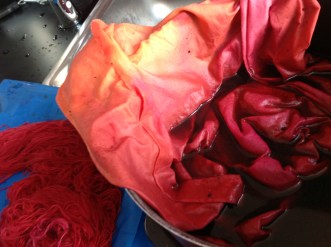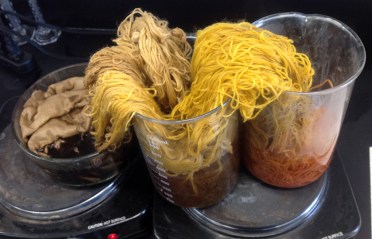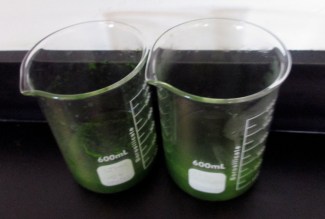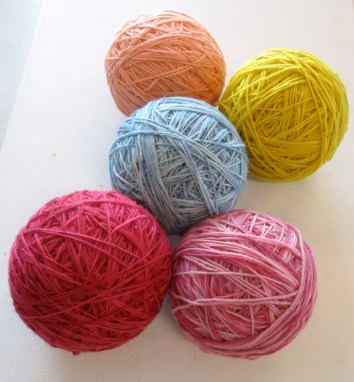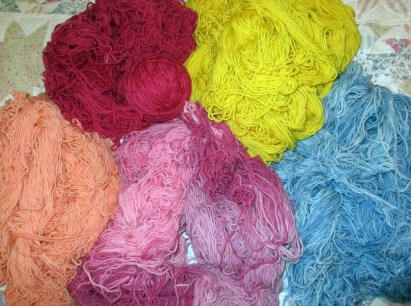
Martin Luther King, Jr. monument in Washington, D.C. He had a dream of a world without barriers or borders.
Over the next six months I’ll be writing a series of blog posts about a new adventure in my life. These posts won’t fit exactly into the parameters I originally set for this site, which were to tell the stories of the chemical elements. Yet I’ve reinvented this site more than once. It became a site about chemistry education, and I am now reporting on my efforts in STEAM education. I haven’t forgotten where I started, but I keep adding more subjects as my own career has expanded. Now I add one more subject area: global education.
My new adventure began in the spring of 2016 when I applied for a program created by the U. S. Department of State. It is a teacher exchange program called Teachers for Global Classrooms. Teachers from developing countries come to the United States to study English and learn our culture for up to six months, then return to their home countries to act as hosts for U. S. teachers. We travel there for 2-3 weeks to experience their culture and educational system.

Part of the Indonesia cohort for the 2017 Teachers for Global Classrooms program. We will be traveling to Indonesia July 13-August 2, 2017.
76 teachers were selected, and I am pleased to say that I will be going to Indonesia for three weeks from mid-July to early August 2017. When I found out in December that Indonesia would be my destination, I was (and still am) very excited. It is part of the Ring of Fire, and has more active volcanoes (125 in all) than any other country. As an Earth Science teacher, this is a very cool opportunity. It has amazing biodiversity, and since it is on the equator, I will get to see the southern stars for the first time. As a student of world religions, I am excited to see how Indonesia’s diverse culture is able to blend Islam with Buddhism, Hinduism, and Christianity.
Now I’m not being a Pollyanna or Pie-in-the-Sky. I know the challenges. I lived for two years in southern Taiwan and know what it’s like to live in a tropical climate, speak a different language, and eat unaccustomed food. It won’t be easy, but that is the nature of adventure. Adventures are the parts of our lives that we tell stories about, the parts that define us.
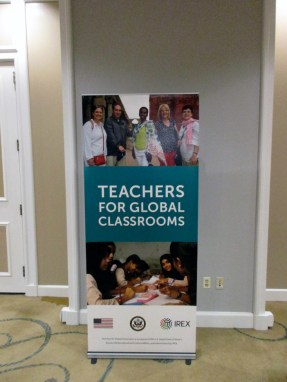
Sign for Teachers for Global Classrooms, a teacher exchange program of the U. S. Department of State. We met in Washington, D.C. on Feb. 16-18, 2017 to prepare for our international experiences.
We’ve been undergoing training in our online course in the fall and at our Symposium this past weekend in Washington, D.C. Part of our discussion has been on the types of stories we will tell about our experiences. We talked about the work of Dan P. McAdams concerning how we define ourselves by the stories we tell about ourselves. He divides these stories into two groups: Redemptive Tales and Contaminating Tales. Imagine that the same tragedy befalls two people. The first tells of the tragedy in terms of redemption – how the experience was difficult but ultimately transforming as the person overcame and transcended the experience. Such people are more likely to be generative, that is, they make positive contributions to society. The other person tells the story as a horrible experience that ruined their life and led to their downfall; the experience contaminated their life. Such people tend to be negative and draw from society instead of contributing to it. As McAdams put it in his introduction to his book The Redemptive Self: Stories Americans Live By (Oxford University Press: 2007):
Among the most eloquent tellers of redemptive stories are those midlife adults who are especially committed to their careers, their families, and making a positive difference in the world. These highly “generative” men and women embrace the negative things that happen to them, for it is by transforming the bad into good that they are able to move forward in life and ultimately leave something positive behind. Unconsciously, they find inspiration and sustenance in the rich store of redemptive tales that American culture offers.
As I write the stories of my experiences in Indonesia, I can choose to be redemptive (focusing on the lessons I learn, the great things that happen, the funny tales, the commonality of humanity, the beauty of the islands, etc.) or I can focus on contaminating people’s perceptions by focusing on the negative: the humidity, the bugs, the population, the traffic (I will be in Jakarta for over a week altogether, and I hear the traffic there is unbelievable), how I miss my family, poor sanitation, lack of personal space, etc. I can choose to be generative or destructive, positive or negative. My choice is to accentuate the good that I find; to build bridges instead of building walls.

Quote by Dr. Martin Luther King, Jr. from 1967. Our Teachers for Global Classrooms experience will promote the type of world perspective he describes.
Just this weekend President Trump spoke at a rally where he again attacked globalization and trade agreements such as NAFTA. He reiterated the plan to build a wall to keep out Mexican immigrants. I’ve walked along the Rio Grande River in Laredo, Texas and seen the discarded wet clothes of those who swam across the river. They bring dry clothes in a plastic garbage bag, then change to the dry clothes and discard the wet on the north bank as they leave the river. I can understand how many people are frustrated because they’ve been left behind by foreign competition, because they’re unskilled laborers that can be easily replaced by automation or cheaper labor oversees. Many people are experiencing a kind of global whiplash.
But the solution isn’t to retreat into isolationism, nationalism, or “America First” jingoism. Every time we’ve tried this, we’ve regretted it. We didn’t want to get involved in World War I because it was “over there” and not our problem. Until it was, and millions died. We didn’t want to get involved in another war in 1939-41, until it rose up and bit us in Pearl Harbor, and then it cost us millions of additional lives. Now we talk of retreating from the UN, re-establishing trade tariffs, and putting limitations on immigration. This will be a bad day for us; historians will say this is where we failed as a country when our mandate was to move forward and embrace the future, not try to hide from it.
So here I am becoming part of a program that promotes global awareness and competence, that aims at peace through mutual understanding, and that strives for better education through teaching 21st Century Skills of collaboration, creativity, and communication. Never has there been a greater need. I realize that Pres. Trump is merely the figurehead at the top of a larger American problem; it is the people who are dispossessed, afraid, underemployed, and unprepared for the reality of the new global economy that have elected Trump and that are cheering him on. Scared people are easily manipulated, undereducated people are easily deceived, and people without information literacy tend to accept whatever they’re told without thinking critically about it. We’ve been thinking these skills are going to be crucial for the next generation. We were wrong. They are crucial NOW. We have already failed to properly educate yesterday’s children who are today’s adults and voters. Now we have a populist president elected out of fear, not hope.

Statue of Eleanor Roosevelt, our first ambassador to the United Nations, at the FDR Memorial in Washington, D.C. She promoted the type of global competence we still need today.
I realize that the last two paragraphs are negative and pessimistic in tone. But I want you to know the rationale for why I am doing this and what my theme will be for these blogs. I hope to promote global bridges of understanding to combat the “othering” and nationalism that seem to be sweeping the world. I choose to have a hopeful view of the future, where humanity will celebrate its commonalities instead of differences, where collaboration and cooperation will work to build relationships and capabilities instead of breaking them apart. Ultimately, I wish to see us become a multi-planet species, where borders are no longer important and barriers to progress are torn down. I want a world where we work together to solve mutual, global problems instead of pointing fingers and doing nothing (or denying they exist).
So these will be the stories I will tell as I embark on this adventure. Please join me! Help me build a few bridges.
